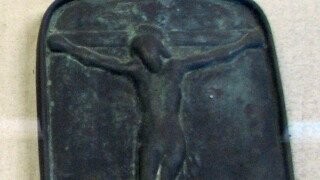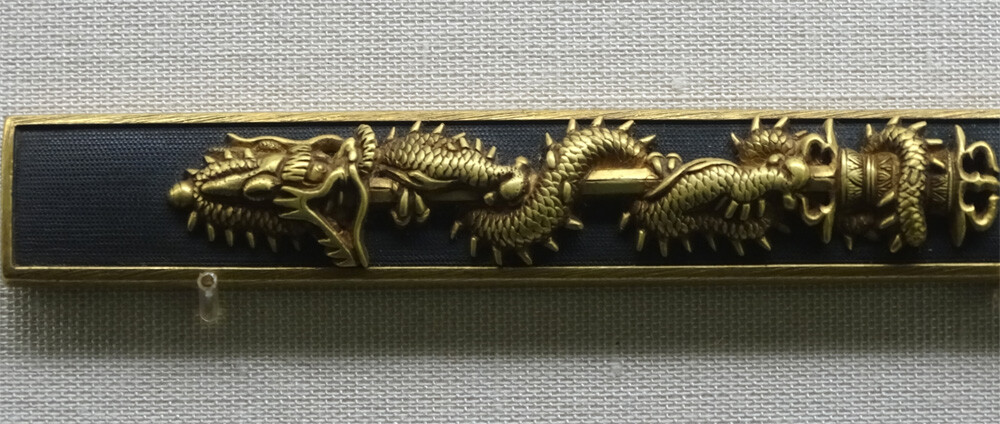4 Stories From The Weird History Of Christianity In Japan

Did you know that Japan had back-to-back Christian Prime Ministers? Between 2008 and 2009, the country was led by Taro Aso, who is Roman Catholic. He was succeeded by Yukio Hatoyama, a Baptist. All in all, eight of Japan's political leaders were of the Christian faith, and they were in some notable company.
The internet's favorite old-school badass, Toshiro Mifune, known for his roles in Akira Kurosawa movies?
Practicing son of Methodist missionaries. The "Japanese Schindler" Chiune Sugihara who saved thousands of people during WWII by issuing them travel visas? A proud member of the Russian Orthodox Church.
Don't Miss
You don't think about stuff like that because Christianity isn't part of the image that Japan has in the West. But the religion actually has a long history in the country, and that history is totally bonkers …
The First Japanese Christian Convert Was A Wanted Murderer
Say what you want about Christianity (and if you're Richard Dawkins, you already did, so maybe get a new thing), but at least it gives you an outlet for when you've done something wrong: confession. No other place in Japan offered this kind of service before the arrival of the first Christian missionaries in Japan in the mid-16th century. That's why, when a samurai known as Anjiro or Yajiro killed a man in Satsuma on the island of Kyushu and fled from the law, he didn't really have anyone he could turn to in order to unburden himself.

He eventually got so desperate and depressed that he just spilled his guts about his crime to the first random person that sat down and talked with him, who happened to be the captain of a Portuguese ship docked in Kagoshima. The guy felt sorry for Anjiro and offered him a job, but the fugitive samurai messed up and reported to the wrong ship, where he immediately started confessing again to his murder and how much it sucked to be an outlaw. Instead of saying, "Probably not as much as it did for your victim," the other ship captain offered a solution: he would take him to talk to a Catholic priest. The nearest one happened to be a mere 2,700 miles away, in Malaysia. Realizing that there were people there he hadn't yet told about his crime, Anjiro agreed to travel to Malacca.
There, in 1547, he met Francis Xavier, Jesuit missionary and later saint, who talked to Anjiro (the samurai had by then become pretty fluent in Portuguese) about God and forgiveness and asked the man if he thought that Japan was ready to embrace Christianity. Anjiro basically said: "Maybe?" to which Xavier replied, "Good enough! Let's go!" They first traveled to Goa, where Anjiro was baptized as Paulo de Santa Fe, making him the first official Japanese convert to Christianity. Finally, Francis Xavier arrived in Kagoshima in 1549 with his personal X-Man in tow, who unfortunately turned out to be a slightly worse version of Cypher.

When Xavier, with Anjiro acting as his translator, started preaching Christianity in Japan, everyone thought it was another school of Buddhism because Anjiro translated the Portuguese word for God, "Deus," as "Dainichi," the Japanese name for Vairocana, the Primordial Buddha. Actually, coming up with the right translation for "God" turned out to be quite the challenge. Originally, Xavier wanted to go with just the word "Deus," but due to the syllabic nature of Japanese, it would have sounded like "Deusu," which was a bit too close to "Dai-uso," meaning "Big Lie" (now taking bets on how many comments under this article will say "I GUESS THE TRANSLATION WAS CORRECT THEN! Lololololol!")
Xavier was recalled back to Goa in 1552, leaving the mission in Kagoshima in Anjiro's care. It folded two years later, after which Anjiro became a pirate and died during a raid in China, probably while yelling out more details about the murder he committed.
Christians Helped End Slavery In Japan (By Doing SO MUCH Slavery)
Here's another thing people tend to not associate with Japan: for well over a millennium, the country had a functioning system of slavery. We're talking about Japanese people enslaving other Japanese people (and later other Asians) and making them work on farms and in households since at least the third century. The whole history of slavery in Japan is quite complicated since the institution wasn't monolithic. Some slaves just worked off debts, others were prisoners of war, and some were outright property whose slave status was inherited by their children. This went on until the 16th century.
During the 1590s, Toyotomi Hideyoshi, the de facto leader of Japan at the time, outlawed chattel slavery (the other kinds were still A-OK, though) but didn't exactly do it out of the goodness of his heart. He just didn't like how many Japanese slaves were bought up by white foreigners.

Yeah, in the 16th century, Japanese slaves were the must-have item for Portuguese Christians throughout their Asian colonies, though many of those slaves also ended up in Europe. The King of Portugal eventually started to worry that maybe, just maybe, buying up whole villages-worth of their people would make it harder to convince the Japanese to convert to Christianity. "Come on over to the Jesus Club! We already have all your cousins" is not the best marketing slogan ever.
We don't have the exact numbers on how many Japanese slaves were bought by the Portuguese, but it was A LOT. So much so that they flooded the market in Portuguese colonies in China and India, causing their prices to drop so low that Japanese slaves were bought by other, non-Japanese slaves. Hideyoshi was reportedly disgusted by all of this but, again, it wasn't so much about the act of slavery itself, as Hideyoshi would do just a shitload of slavery during his invasions of Korea a few years later, but more about them being sold to a bunch of strangers with some weird foreign religion. So alongside a ban on selling Japanese slaves, he also banned preaching Christianity in Japan.
Unfortunately, he did not stop there.
Japanese Christians Had A Whole Form Of Torture Invented Just For Them
Within 50 years of Francis Xavier's arrival in Kagoshima, between 300,000 and 500,000 Japanese people converted to Christianity. This started to worry Toyotomi Hideyoshi. On the one hand, it's undeniable that Portugal and Spain (which also joined in on the Christianization effort) saw spreading religion as both their holy mission and a useful tool for gaining a foothold in a foreign country to slowly expand their political power there. But it's not like either country was planning an active takeover of Japan or anything. That didn't matter, though, because, near the end of his life, Hideyoshi became extremely unhinged and paranoid. It's a miracle he didn't order the arrest of "that guy who always stares at me from inside my sword whenever I'm polishing it!"

This culminated in tragedy when, in 1596, the Spanish ship San Felipe was shipwrecked in Shikoku. The local feudal lord ended up seizing its cargo, and the incident eventually moved its way through Japan's legal system all the way to Hideyoshi. Due to a mixture of misunderstandings, poor translations, and the ship's pilot trying to flex on the man who ruled Japan by saying that Christianity is how Spain and Portugal prime a country for conquest, Hideyoshi just lost it.
Encouraged by anti-Christian factions in his government, he ordered the expulsion of all foreign missionaries from Japan. He actually issued a similar edit almost 10 years earlier (aimed at Jesuit zealots), but no one took that one seriously, including Hideyoshi. In 1597, though, he wanted to make sure everyone knew he meant business. Hideyoshi rounded up 26 Japanese Christians and had them tortured and crucified in Nagasaki.

This marked the beginning of nearly 250 years of Christian persecution in Japan. More Christians would be executed over the years, with the modern Catholic Church recognizing over 400 Japanese martyrs, including 42 saints. In the 1630s, well after Hideyoshi's death, the country closed itself off from the outside world, which stopped the flow of missionaries, so all they had to deal with were the remaining Japanese Christians. Sadly, this is how they dealt with them:
From the beginning of the 17th century, Christianity was outlawed in Japan, though many people still practiced it in secret. If you got caught, you had a chance to renounce your faith. But if you refused, you went into the hole. The ana-tsurushi ("hole hanging") torture involved hanging a person upside down and lowering them into a hole filled with feces. Cuts would be made on the victim's forehead or wrists to cause their blood pressure to drop, and the hole itself would be boarded up so you'd just hang there in total darkness, getting woozy from the blood loss and shit vapors. MANY Christians went into the ana-tsurushi hole. Not many came out.

via Wiki Commons
Not just because the torture was very effective in getting people to unsubscribe from the Church. A lot of people refused to abandon their faith until the bitter end, like Saint Lorenzo Ruiz, the first Filipino martyr ever. A lot of this was covered in Martin Scorsese's Silence, which also mentioned another way Japan tried to dissuade people from Christianity:
Suspected Christians In Japan Were Forced To Step On A Picture Of Jesus Or The Virgin Mary
After kicking out all the missionaries from Japan in the 17th century and banning the practice of Christianity, the shogunate allowed the Netherlands to trade out of Nagasaki on account of them being Protestants. The similarity between their wooden clogs and Japanese geta sandals probably also helped. But no nation is a monolith, so, the Japanese government reckoned, there was a chance that a Catholic was hiding among the Dutch traders. And if they suspected that someone was visiting Japan to secretly preach, they made them tap-dance on Jesus' face.

Fumi-e (literally "stepping pictures") were only brought out when port officials had reason to believe you were in Japan for something other than inspiring the country's gay electro-ronin. They were not the standard treatment for every foreigner visiting Japan, but they were for the residents of Nagasaki. Nagasaki was at one time called the Rome of Japan because of how many Christians lived there. After the ban on the religion, though, the government tried to root all of them out. This eventually led to an annual mandatory test held in public halls and private residences where officials would bring out a likeness of Jesus or the Virgin Mary and have you do a little jig on it. If you refused, into the shit-filled horror hole you went. This was eventually done away with, though, and replaced with straight-up executions.
The fumi-e portraits were originally made from paper, but the material proved too fragile given the frequency of the test, and the government probably didn't like the idea of having painters sit around all day making pictures of Jesus. Wood and bronze fumi-e were most popular, but to ensure that they didn't become objects of worship, they were kept under lock and key. Yeah, you wouldn't want people doing something weird to them, like praying. These works of art were made strictly for wiping your feet on.

Of course, many Christians would tread on the paintings, publicly renounce their faith, but keep practicing in secret. Still, over the centuries, this practice helped reduce the Japanese Christian population to just about 20,000. Even today, in an era where Japan kind of sort of celebrates Christmas (even if it's not a public holiday), many Japanese Christians like to keep quiet about their faith. Almost as if 50% of their history in the country was a constant parade of torture, being strung up in literal shit holes, and gruesome executions, including being boiled alive. Weird.
Follow Cezary on Twitter.
Top Image: Chris 73/Wiki Commons
